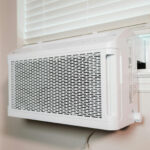Mould is an adaptable organism that can take root in almost any part of your home, thriving in both visible and hidden areas. While it often makes its first appearance in damp places like the bathroom and basement, mould can also establish itself in surprising, less obvious spots. There are a number of unexpected places mould can thrive in your house – find it before it has an impact!

When you learn that mould can pose a significant health risk, it becomes clear why maintaining a relatively mould-free home is crucial for your wellbeing, and those of your loved ones.
Mould’s Hidden Hideouts in your Home
Inside your Washing Machine

The warm, damp environment inside your washing machine can be a perfect breeding ground for mould. This is especially true in areas like the detergent drawer and door seal.
Tips :
- Regular Cleaning: Make it a habit to regularly clean the detergent drawer and door seal.
- Leave the Door Open: After each use, leave the washing machine door open to let the interior dry out. This simple step can significantly reduce moisture and prevent mould from forming.
- Use Cleaners: Consider using a washing machine cleaner or running an empty hot water cycle with some white vinegar. Both methods are highly effective at killing any lingering mould spores.
Windowsills and Seals

Windows are prone to condensation, which can lead to mould growth on sills and frames, especially during cooler months.
Limit Mould on Windowsills and Frames:
- Regular Wiping: Frequently wipe down windowsills and frames to remove moisture and dirt that has built up.
- Ensure Proper Ventilation: Good airflow is crucial. Open windows or use fans to ensure proper ventilation, reducing the chance for condensation to build up.
- Protect Wooden Frames: For wooden window frames, applying a protective sealant can help prevent moisture absorption.
Cleaning Tip: If you do spot mould around a window, don’t panic! Scrub it off with a clean, used toothbrush using a 50:50 mixture of white vinegar and water. For persistent condensation issues, consider repairing window seals or replacing sashes to keep your windows in top shape.
Air Conditioning Units

Air conditioners, while keeping us cool, can trap moisture and dust, creating a perfect environment for mould, especially in the coils and ducts.
Prevent Mould in Your Air Conditioning Unit:
- Regular Maintenance: Make it a routine to change filters and clean coils regularly. This essential upkeep prevents mould build-up and ensures your unit runs efficiently.
- Control Moisture Levels: Using a dehumidifier can help manage moisture in your home, making it less attractive to mould .
- Professional Support: Sometimes, mould can be stubborn. If you notice a persistent problem, hiring a specialist company can be a smart move. They have specialized equipment and techniques to detect and remove mould from your AC unit effectively.
Dishwasher Seals and Filters

As a normal part of its function, food particles and moisture easily builds up in your dishwasher’s seals and filters, creating a perfect environment for mould.
Preventing Mould in Your Dishwasher:
- Clean Seals and Filters: Make it a habit to periodically clean the seals and remove and wash the filter.
- Run an Empty Cycle: Occasionally run an empty cycle with vinegar or a dishwasher cleaner. This helps to ensure overall cleanliness and tackle any hidden mould spores.
- Proper Dish Care: Did you know mould can even grow on dishes stacked wet and left unused for several days? To prevent this, run the dishes through a hot cycle in your dishwasher and then dry them completely with a towel ahead of storage.
Up in the Attic

Poor ventilation and roof leaks can cause moisture to accumulate in your attic and its insulation, creating a breeding ground for mould.
Ways to Prevent Mould in Your Attic:
- Regular Inspections: Make it a habit to inspect your attic regularly for any signs of leaks into this space. Catching them early can prevent moisture, and then mould, build-up.
- Ensure Proper Airflow: Good ventilation is key.
- Address Mould Promptly: If you do find some mould, it’s essential to replace the affected insulation and address the source of the moisture immediately. Fixing the root cause will help to limit and prevent future problems.
Houseplants and Soil

Overwatering your houseplants can lead to mould growth on the soil and plant surfaces because of the constant dampness. But don’t worry—keeping your plants healthy and mould-free is easier than you think!
Steps to Prevent Mould on Houseplants:
- Mind Your Watering Habits: Allow the soil to dry out between watering.
- Remove Visible Mould: If you spot any mould, remove it immediately by carefully scooping it off a layer of the soil where it has set up home to stop it from spreading further. This mould also becomes a food source and breeding ground for plant gnats, so dealing with any mould that appears can take care of both issues in one!
- Use Natural Mould Inhibitors: Sprinkle a layer of cinnamon or activated charcoal on top of the soil. These natural substances act as mould inhibitors, keeping your plants safe and sound.
Chimneys

Your home’s chimney can harbour hidden mould due to trapped moisture and lack of ventilation.
- Regular Inspections and Cleaning: Schedule annual chimney inspections and professional cleaning.
- Proper Ventilation: Ensure your chimney is well-ventilated to reduce moisture buildup.
- Moisture Barriers: Install chimney caps and waterproofing sealants to keep out rain and dampness.
Pet bedding

Your pet’s bedding can be a breeding ground for mould if it remains damp and uncleaned.
- Frequent Cleaning: Wash and dry your pet’s bedding regularly to prevent mould growth.
- Dry Environments: Keep pet bedding in a well-ventilated, dry area to minimize moisture.
- Replace Regularly: Change out old bedding materials periodically to ensure they remain mould-free.
Understanding the unexpected places where mould can hide in your home and the dangers it poses is important for maintaining a healthy living environment. By staying vigilant and proactively seeking out these hidden spots, you can prevent a small problem from becoming a serious, destructive issue. Regular inspections and maintenance make all the difference in catching mould early and limiting its impact.